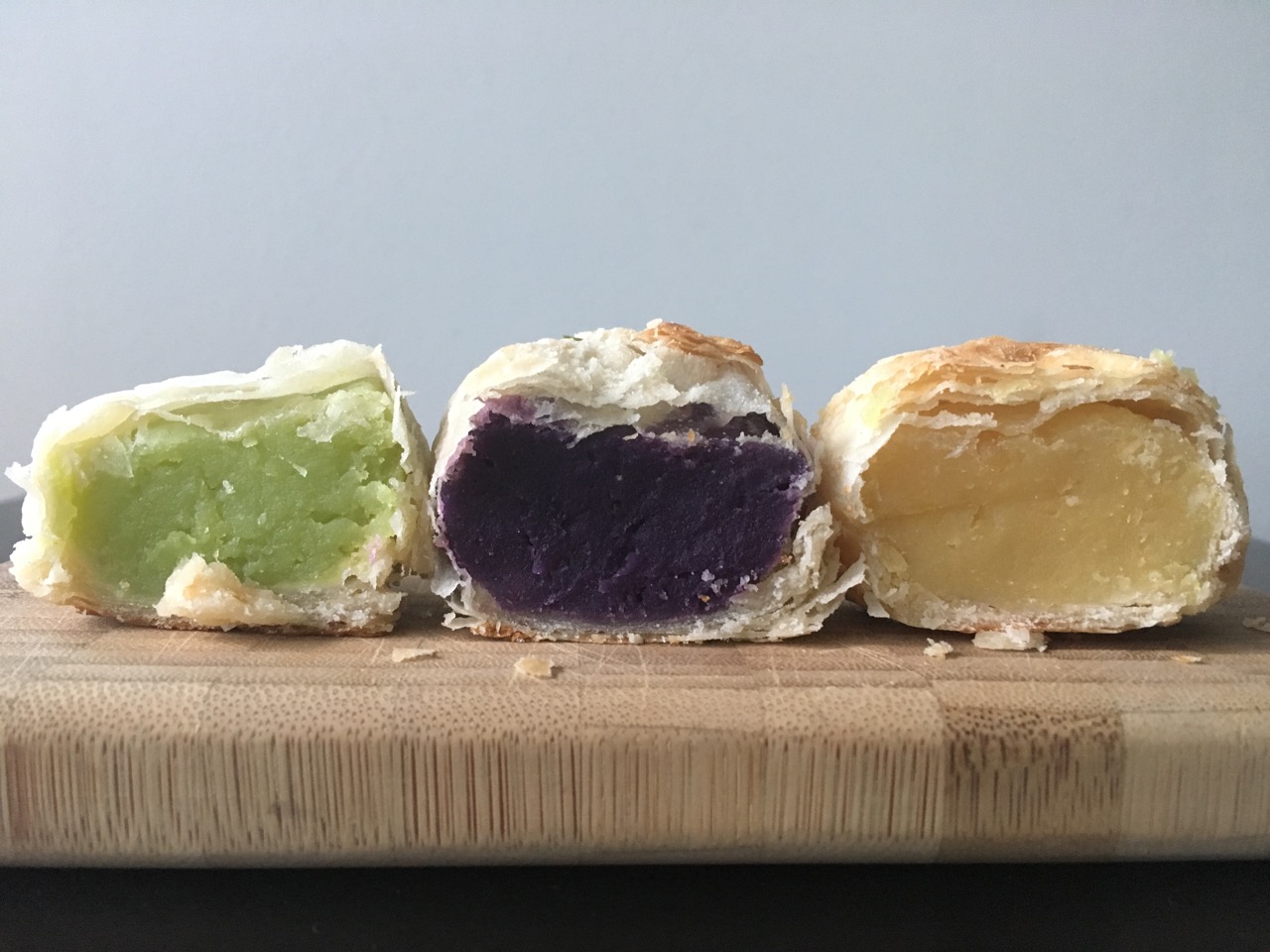“PART OF IT WAS JUST BOREDOM,” Joaquin Soler says, laughing. “Getting bored with all the meat.”
A barbecue man isn’t supposed to say that, but he’s not the first one I’ve heard talk that way. You get the hang of a few meats—brisket, ribs, chicken, whatever—you’re the master of those masculine arts, and then your menu is set. Forever.
“The other part was, frankly, this is a really difficult kitchen to work in,” he says. “Because it’s so tiny. And even though the first iteration of the Smalls menu wasn’t so large, it was the fact that everything we were doing was from scratch—and continues to be. It was pretty intense.”
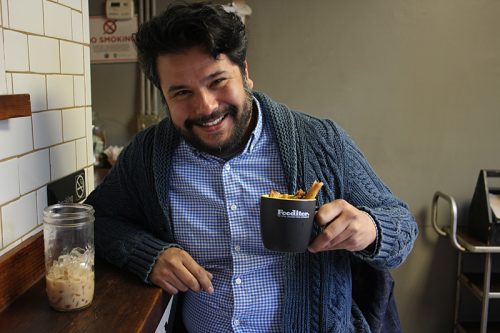
Joaquin Soler with mug full of lumpia.
I see what he’s saying, but I’m not sure how making your menu twice as long solves these problems. “The fact that so much of it was to go, it’s not like you can course it out. It’s just all fire and set,” he says. “I didn’t see quality going down, but the busier it got, the crazier it became to maintain. I didn’t want it to be this thing where my guys were stressing out so much. Churning out food, brisket brisket brisket, bibim bibim bibim. And at the same time, they were getting bored, too.”
The answer was there in their sales records, if they took the time to look at them. “We looked at what was selling, and it was the Filipino stuff.”
WHAT WAS GREAT ABOUT SMALLS Smoke Shack & More when it opened in the summer of 2013 was that it did solid Texas-style barbecue, honed on Soler’s former Brown Bag Lunch Truck. But where most barbecue restaurants offer a sometimes perfunctory list of American sides—fries, baked beans, cole slaw, etc.—Smalls offered garlic rice (a Filipino standby), grilled elotes (a Latino one), and grilled shishito peppers (one of the signs of spring in chef-driven restaurants).
All that was refreshing, but even better yet was the combination of Texas with Asia in brisket bimbimbop, in which, as I wrote at the time at Serious Eats, “the smoky salty greasiness of the brisket transforms everything it soaks into, imbuing it with a late night honky tonk vibe bibimbap has never known before.” For a while I said, only partly joking, that my standard for Michelin-level fine dining was, does it taste as good as Smalls’ brisket bibimbap?
So again, it’s a little surprising for a barbecue man to say “What I’m really excited about is that we’re not so meat-centric as we used to be.” He explains: “There’s this big misconception about Filipino food, that it’s really meat-centric. And it’s not. I grew up there, I know! Over there, the flavors are so punchy because they’re all meant to flavor the rice. The rice is always the star of the show, a big portion of rice. A little salty thing of meat here, a little spicy thing of some weird leaf over here, a piece of dried fish, some pickled mango—but it’s all about flavoring the rice.”
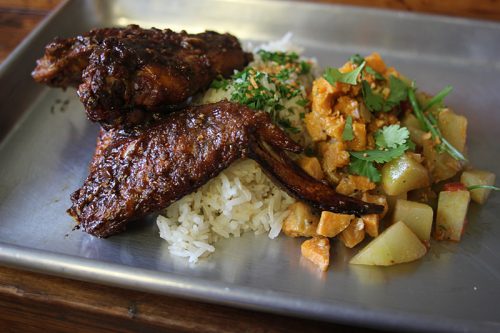
Chicken Inasal (Filipino barbecued chicken wings), with garlic rice, sweet potato and chayote. “Traditionally inasal is a very citrusy, roasted chicken. A lot of times they use annatto for coloring. We actually do a brine on it, oddly enough a pickle brine from our housemade pickles. And then we smoke them over applewood, like everything else, and then we char-grill it, and then we toss it in that sauce.”
Soler’s first major cooking job was at Rambutan, an ambitious neighborhood Filipino restaurant that was first in Avondale, then in Wicker Park. Despite critical attention, it only lasted four years (1998-2002) at a time when Filipino food was largely unknown in the city.
Filipino foodies talk frequently about whether this is finally “the Filipino moment”—the time when their food becomes as widely appreciated as Chinese or Korean or Thai. Smalls’ popularity seemed to be a good sign for Filipino food finding a broader audience in Chicago at last. “It’s something that’s always been near and dear to my heart. We decided just to roll with it,” he says.
There’s this big misconception about Filipino food, that it’s really meat-centric. And it’s not. I grew up there, I know!
Soler’s plan is to scale back the meats a little, going to a rotating schedule, while increasing the number of Filipino dishes—which are less work-intensive to prepare. “The thing about Filipino food is that, it’s a lot like Indian food, so much of it can sit for a while,” he says. “We’re cooking a lot of the stuff sous-vide, and we’re able to hold things for a while and the quality maintains. So we kind of patterned it after cafeterias in Manila and the Philippines, turo-turo—literally, point-point.”
“I thought there was room for that, and to present the Filipino food that I grew up with. Because the food that I grew up with is a lot different than what other people grew up with. I grew up in Manila, and the adobo that I grew up with is called adobong puti, or white adobo, because it doesn’t have the soy sauce. Soy sauce is actually an addition to adobo, it wasn’t originally part of it—adobo is just bay leaf, garlic, vinegar and salt.”
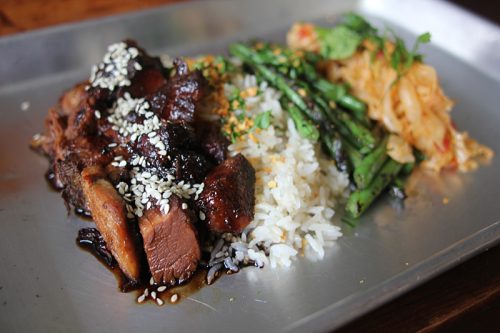
Humba, brown sugar-Filipino-soy-braised pork shoulder, with garlic rice, charred longbeans in house spice blend (five spice, salt pepper and toasted garlic), cabbage sautéed with sofrito.
Soler came to the U.S. when he was a kid, and at one point his mother ran an art gallery dedicated to promoting interest in Filipino art. Occasionally she also dealt in books for Filipino book collectors, and he says that from about age 12, he was in charge of reading the books and writing them up for the catalog. “A lot of them were about Filipino food, and the effect of colonization on Filipino food, and the regional history of Filipino food,” he says. He’s been a student of the variety of Filipino cuisine ever since, and one thing you notice is that he’s fully adopted the Filipino soy sauce, a little darker and funkier than the Japanese kind, despite not growing up with it—you see it in a lot of his Filipino dishes now.
“It’s not as refined,” he says. “It’s a lot more savory than like Japanese or Korean soy, it’s got this umami punch to it, and it works beautifully with anything sour or bright—with vinegar, with citrus. Those little Filipino key limes, the kalamansi, it works amazingly with that. That’s like a super-simple marinade that makes everything better.”
“The deeper we delved into Filipino food, it became clear that what we were doing at Smalls wasn’t so far off,” he says. “So much of Filipino food is about those contrasts. If there’s something hot, there’s something cold. If there’s something sour, there’s something sweet. If there’s something rich, there’s something to cut through it.”
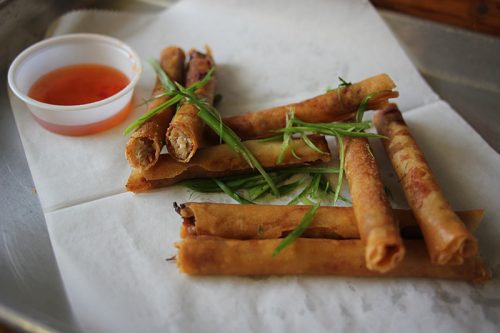
Lumpia Shanghai, with pork, garlic, and napa cabbage. “A lot of people think they’ve never had Filipino food, and then they see these and go, oh, I’ve had lumpia. We go a little thinner, and we make the filling a little more savory, a little more gingery.”
EARLIER THIS YEAR HE SHUT DOWN Smalls for a few weeks to work on a new menu with a rotating schedule for the smoked meats. “When we reopened, we did this little soft opening for a week, just dinner, and we kind of figured out what needed to stay on the menu, permanently. Fried chicken needed to be on there; smoked tofu, there would have been an uproar if we didn’t have that. Odd to think, but yeah, we do have a lot of vegetarians,” he says.
“We’re still figuring out the schedule, so typically on the weekends we will be running the brisket and pulled pork. Wednesdays and Thursdays, that’s usually when we run our ribs. And we’re doing bibimbap every day for lunch. But we needed to back off a little to keep doing it right.”
It was a little nerve-wracking for him at first. “People were coming in, where’s this, where’s that. You could sense the disappointment. But then we got them to try other things. And then Wednesday night, some of the people who came in Tuesday night came back to try other things. ‘Let me try that beef dish you had last night. Do you have that pork dish again?’ No, but we have this pork dish. ‘Okay, we’ll try that!'”
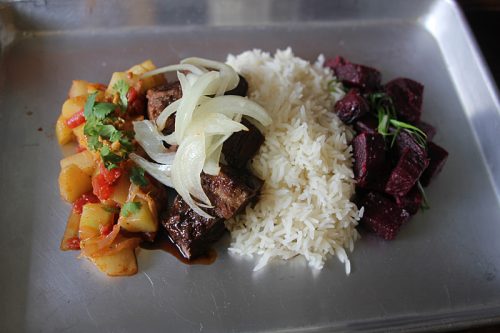
Bistec de gallo, brisket in Filipino soy sauce, kalamansi juice and garlic, beet home fries with Japanese-style spicy mayonnaise, steamed rice, chayote squash with Filipino sofrito. “That’s how I grew up eating bistec. It’s all about those onions. We confit those in brown butter. Bistec de gallo is usually top round or something like that, but we sous video brisket in all those ingredients.”
I ask him if he’s really seeing his non-Filipino audience adapt to the new menu items. He says, “They are! They’re digging them. Now, we haven’t thrown in too much of the 400-level coursework at them. We’re working on it. The Philippines is an archipelago of 7000 islands, there’s thousands of ways to make things. You can get into all these discussions of authenticity, but the bottom line is, does it taste good? If it does, the discussion’s over.”
And so Smalls is a little more Filipino, a little more vegetable-focused—but still a place you can get Texas-style barbecue, if that’s what you want. Soler’s next ambition is to increase the authenticity of this new vegetable focus—by growing his own Filipino vegetables.
“We’re partners in this farm in Michigan, and we’re growing a lot of stuff now,” he says. “A lot of different kinds of eggplant, a lot of chilis, several different versions of longbeans, and we’re really just looking forward to playing with all this stuff.” The farm, located near Three Oaks, belongs to a longtime customer. “They have what basically amounts to a hobby farm. The summer before last, I did a couple of catered events there, and I started growing stuff—I started growing tomatoes that we’re using in a couple of dishes.”
“Last year we did another practice run, and this year we’re really going to try to have a go at it,” he says. “Last year we did a lot of preserves and pickles that I’m sitting on right now—I’ve got all these different jams and confits. And this year I really want to get a lot of those vegetables in here. So it’s about training the crew there to really know when it’s time to pick these things. I’m still researching Filipino vegetables—I’ve got my mom and dad in Manila, and they’re trying to figure out what will work over here.”
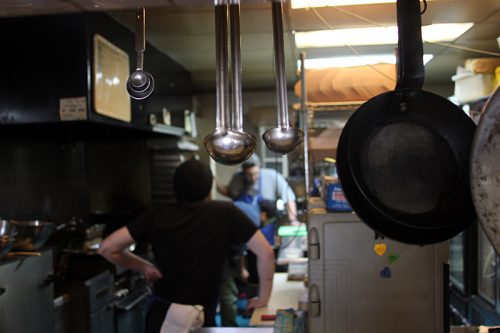
Michael Gebert is the big lumpia of Fooditor.
Latest
Join the Discussion
After you comment, click Post. If you're not already logged in you will be asked to log in or register with Disqus.







